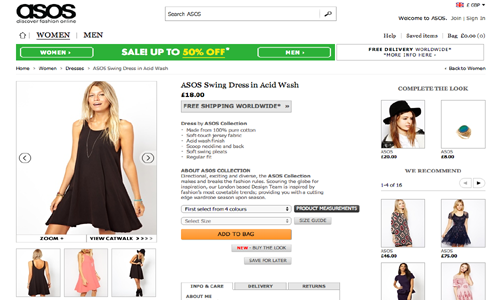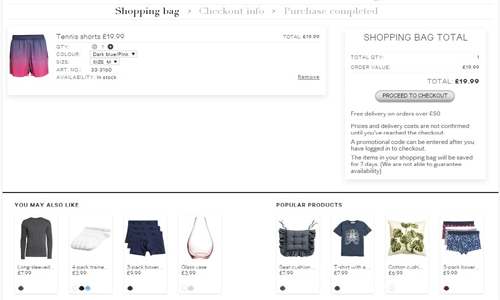Maybe you read our recent blog and already learned how to increase sales, you have already built up a steady trickle of customers to your eCommerce store providing you with a reasonable income but having a few more tricks up your sleeve won't do any harm. One way to drum up some extra sales from your exisiting customers is to introduce cross-selling. Most of the world's biggest companies do some form of cross-selling, if it works for them, it can work for you too.
The great news is that you won't have to make big changes to the way you sell or the website you sell through, just a few small tweaks and minor changes can really make a big difference to your business's profits! It's great customer service too as you are introducing complementary products to customers and enhancing their experience. Without further ado, let's get into what cross-selling is, how you can benefit from it and what you can do today to start!
What is cross-selling?

Cross-selling is when a business suggests additional, 'add-on', products or services to items customers are already interested in buying. You will no doubt be familiar with the practice: when adding an item to your basket on some popular websites you are then presented with "here's what other customers bought" or "you may be interested in..."
Not to be confused with "upselling", which is the promotion of an upgraded or more expensive purchase. Cross-selling can be a more subtle and less obtrusive selling tactic, so it's great for businesses to dip their toe in the strategic sales pool.
There are four main types of products that are most used for this kind of selling:
- Complimentary products: these are things that are used directly with the original product(s), like felt pads to stick under the legs of a new armchair or a matching cushion
- Related products: these are things that aren't necessarily vital but would go nicely, like a sun hat when a customer buys sun-tan lotion
- Bundles: businesses can bundle items together to encourage the customer to buy groups rather than individual items
- A service: this is something that can be included to benefit the item they have bought, say, like a virus protection software to go with a new computer
You can use one or all of these for your online store, we suggest evaluating the products you sell and matching one or two items to each one to start with. "Is is it worth the hassle?" we hear you ask, well…
Why should I be cross-selling?
Well to put it simply: it works, that's why you should be doing it! In 2006 Amazon revealed that their eCommerce cross-selling and upselling techniques accounted for 35% of their sales. For a company that earned over 11.59 billion in 2019, that's a pretty decent pay day!
It's also an easy and subtle tactic to incorporate into your existing website which has the added benefit of improving the customer experience: by presenting them with items that complement their purchase you are saving them the hassle of searching for them and providing them with a 'one stop shop' for all their needs.
As with anything there are some points to consider, let's examine the pros and cons of cross-selling:
Pros
- Increases basket size
- Increases overall profits
- Introduces customers to more products/services
- Saves customers time in finding matching products
Cons
- Needs a variety of products to be done well
- If irrelevant products are offered, it can be off-putting
- Time-consuming to set up
It's pretty clear that the cons certainly don't outweigh the benefits of the pros, so we think learning how to cross-sell online is a win-win situation for you and your customers!
What should I cross-sell?

Almost everything can be cross sold. Most products have a complementary item or service you can offer with it. If you are selling electronic items then you can offer protective cases or spare batteries. For skin care products or make up items why not offer a travel case or brushes? For pet food suppliers consider a range of treats that complement the food you sell.
However, whilst everything can be cross sold, there are some things to keep in mind:
Keep it relevant
This is the golden rule. Selling in this manner only works if your customers understand the relationship between the products your offering and the one they're interested in. The more relevant, the more likely they'll be to add to their cart and checkout.
Take ASOS as a good example - they use their product photography to create an outfit that the model wears to show the item.
Then just below the item, they include the description and price of the individual items that make up the whole outfit. This way they offer complementary items and visually demonstrate how they go with the primary product!
So, if a customer is interested in face cream don't offer them a footbath!
Keep it affordable
Another principle to take heed of when learning how to cross-sell, is to never suggest products that cost 60% more than the primary item. Offering items that cost far more than their initially desired purchase won't convince them to add more to their basket and it may even turn customers off so you lose the initital purchase.
Customers that came to you to purchase a well priced, affordable hat, won't want to check-out a basket filled far over their intended spend limit.
But, on some occasions, if the customer is given the option to receive free shipping if they spend over an arranged amount, more expensive suggestions can work. That's where we come in - at Interparcel our affordable parcel delivery services allow small businesses the opportunity to offer free shipping by reducing shipping costs!
We integrate with all the major eCommerce platforms like WooCommerce, Etsy and BigCommerce so accessing our shipping solutions is easy. With us, you can cut costs and learn how to cross-sell products of a higher value. In doing so you can increase profits and get customers trying more of your product range!
Get a quote with our easy to use tool.
Understand your customers
You may already have a list of products that complement each other and want to begin building bundles that can increase eCommerce cross-selling opportunities. When doing this, think about what your customers may be looking for when they visit your store. Have a look at existing orders, what do customers normally purchase together? Take this research and then offer those items to other browsing customers.
Understanding consumer behaviour can help with this process; when shopping both online and in-store, customers are looking for the best deals for their chosen product(s). If you create a bundle of products that include their primary item and one or two complementary items for a small increase on the original price, your customers will probably see this as a good deal.
All of us consumers want to make our pound stretch further, by creating deals and bundles for customers you increase their basket size (and spend) while they gain exciting products, everybody wins - especially you if they fall in love with those new products and become repeat customers!
When should I cross-sell?

As a general rule of thumb businesses should only try and suggest additional items on the product page or at checkout. But that's not to say you can't put your own twist on it. Depending on what website builder you use, like Shopify, cross-selling online can be much easier. With their built-in functionality, you can create product options wherever you would like.
Checkout cross-selling
If you're wondering how to cross-sell products here, make sure you're generally offering lower priced items. Think about when you go to the counter at any supermarket or retail store, what do you see? Usually some chewing gum, or hairbands, but typically something small and cheap.
Placing items that cost on average 10% of the main product is effective here, as it won't take very much convincing to add these to their basket, both online and in-store.
Product page cross-selling
When deciding which items should be suggested on your product pages, you can often offer slightly more expensive products than you can at checkout. Ranging from around 15-50% the cost of the main item, these products do have to be less pricey, but not always super cheap!
When deciding how to cross-sell products here, try to be helpful and suggest items that the customer will appreciate are useful relations. The more you tailor your suggestions to your customer's needs and wants, the more likely it is to work!
Don't be afraid to show your successes! Customers will be much more comfortable adding products to their basket if they see 'Customers also bought' or 'Related popular products'. Why not include reviews of additional products, or services to show how other customers enjoyed using multiple products together.
Well, if you liked this blog why not read about how ecommerce shipping strategies can also boost your sales?
See what we did there? Cross-selling can increase profits, expand customer experience with your products, and even garner you a few excellent reviews along the way!










 Facebook
Facebook Twitter
Twitter Instagram
Instagram Linked In
Linked In YouTube
YouTube